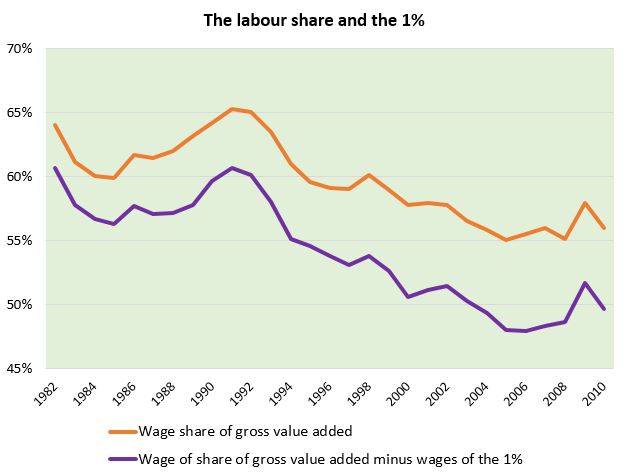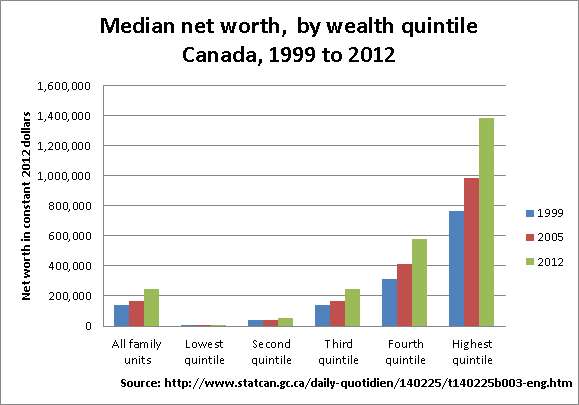It’s easy to get confused about who is a worker and who isn’t these days. Your CEO may worker longer hours than you, not the top-hatted capitalist of the Monopoly board he. Indeed, it may seem that the leisure class of the turn of the last century has been replaced by the workaholic professional and managerial class of today. Yet, if everyone is a worker and no one is a capitalist, then how can we still be living under capitalism?
The short answer is we can’t…or, better yet, we are, which means that not everyone can be a worker, no matter how hard they try and how many hours they put in. These reflections are a continuation of something I just posted on the Progressive Economics Forum. With all the talk these days in Canada about income inequality and the shrinking middle class, I thought it might be a good idea to take another look at the labour share of income. I concluded that post with the following chart.

I think this has some of the answers as to why it is unhelpful to talk about the very highest income earners as workers. The reason is economic power, for which the labour share of income is a proxy. The widening gap between the income share made up by total employment income and the employment income of the bottom 99% shows precisely a gap in power. The highest earners disproportionately affect the power of labour, but they do so not as uber-workers but as something different entirely.
A focus solely on inequality will miss the structural relationships that lie beneath a seeming inequality between equals – more or less income, but all going to workers of one kind or another, the CEO kind and the call center kind or the welder kind. In fact, however, there remains a fundamental difference precisely in kind between most workers and those who maintain control over large portions of productive capacity as highest-level managers, financial professionals and so on.
To be sure, there have been important changes in the structure of the economy that have led to the present situation, one in which the wealthy derive more of their income from labour – there is no direct line from the barons of old to the CEOs of the digital era. Many possible historical factors could be at play. A few that might have something to do with it include the blending of managerial and ownership functions as a kind of institutional capture by managers, successive technological revolutions that have led to new models of the enterprise and increasing financialization that has created a small but powerful class of financial professionals.
Alongside a credible historical explanation, the crux of the matter remains the maintenance of a system of economic power and control. Those at the very top of the income distribution (a group larger than just the 1% though this an easy shorthand) are able to influence both the production process – whether directly through their role in management or through financial pressures – and the distribution of income as well as wealth throughout society. The high labour earnings of today’s worker-capitalists could be described essentially as rents. Extracted directly from the production process, these rents lay the foundation for maintaining inequalities of wealth and power.
This is the magic of today’s capitalism in some respects. The appearance is that the capitalists are workers and, even better, that workers are capitalists. The top managers of the largest enterprises and the biggest hedge funds are relying on salaries; on the flip side, through pensions, retirement funds and other forms of savings, workers are increasingly roped into stock ownership. All this seeming equalization of roles has not produced any meaningful equality, in fact inequalities are largely staying put or being exacerbated.

The point is not who does what – even the Pope shits in the woods as they say. There are many superficial equalities possible under capitalism. For Paul Samuelson, who helped establish the canon of post-war mainstream economics, labour should be able to hire capital just as capital hires labour. In an odd stroke of luck, somehow only the latter has transpired repeatedly in the half-century since that statement was made. Similarly, we could all be workers…but everyday experience shows that we’re not. Time for the inequality debate to recognize this and start scratching beneath surface inequalities…
PS – These thoughts point why I am looking forward to Thomas Piketty’s Capital in the 21st Century. Although the book has yet to be published in English, Branko Milanovic has written a very thorough and interesting review that outlines some of the main arguments and gives much hope. Although much has been made of income inequality, much less is done to put it into the context of political economy – to examine relationships of power, ownership and control over economic processes, to reach back into history and to think seriously about economic method. Although I am skeptical that a global financial tax can do as much as it seems Piketty wants it to do, it will be refreshing to see an analysis of inequality that goes beyond the superficial level of outcomes.